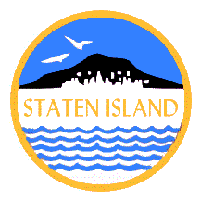Staten Island
 From Citizendium - Reading time: 2 min
From Citizendium - Reading time: 2 min

The flag of Staten Island
Staten Island is one of the five boroughs of New York City. It is coterminous with Richmond County, the southernmost county of New York State. Staten Island is both the least populated area of New York, with a population of 443,728 according to the 2000 census, and the least well-known, which explains its nickname of "forgotten borough", although it has been part of the city since 1683.
The name Staten Island is an anglicization of Staaten Eylandt, the name Henry Hudson gave to the island in honor of the Dutch Parliament, the Staten-Generaal, in 1609.
History[edit]
For centuries prior to the seventeenth century, Staten Island was inhabited by the Raritans, a subgroup within Unami division of the Lenape (Delaware) tribe. The Italian explorer Giovanni da Verrazanno was the first European to encounter Staten Island when he sailed through the Narrows strait that separates it from Brooklyn in 1524; however, it was not until more than a century later, several decates after Hudson's rediscovery of the island on behalf of the Dutch East India Company, that Europeans began settling there.
Four separate attempts were made by the Dutch to colonize Staten Island during the seventeenth century. The first, which began in 1639, was abandoned two years later due to conflicts with Native Americans that resulted in the Pig War of 1641. An even more short-lived colonization attempt was made the next year, but it too succumbed to opposition by Native Americans culminating in the Whiskey War of 1643. A third attempt was begun in 1650 and lasted for five years, but eventually it too fell prey to Native American opposition in the Peach War of 1655. Finally, the fourth and only successful attempt to colonize Staten Island was initiated in 1661 when 19 Dutch and French Huguenot settlers established Oude Dorp (Old Village) on the island's south shore in what is today the South Beach/Old Town neighborhood.
Staten Island was surrendered to the British along with the rest of Nieuw Amsterdam in 1664 and was subsequently renamed the County of Richmond.
 KSF
KSF